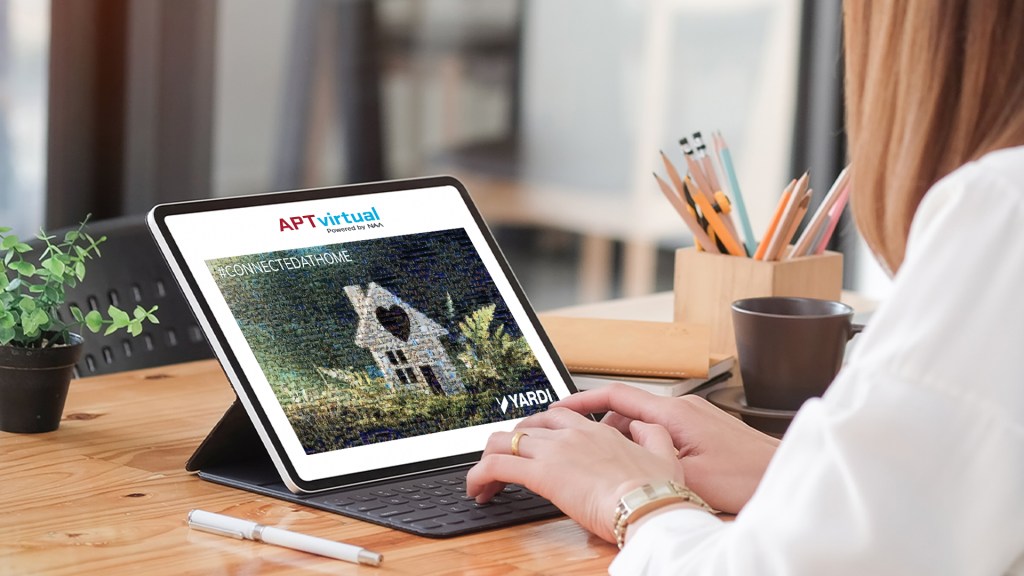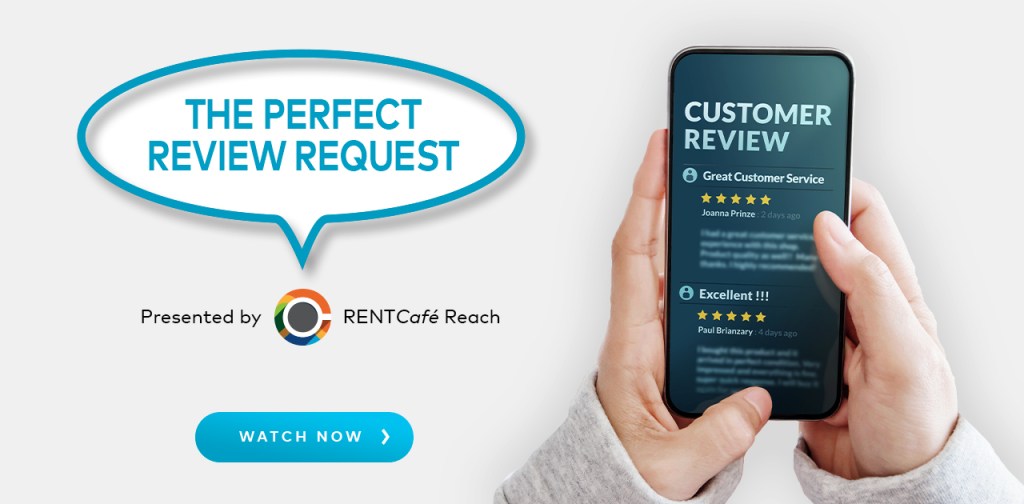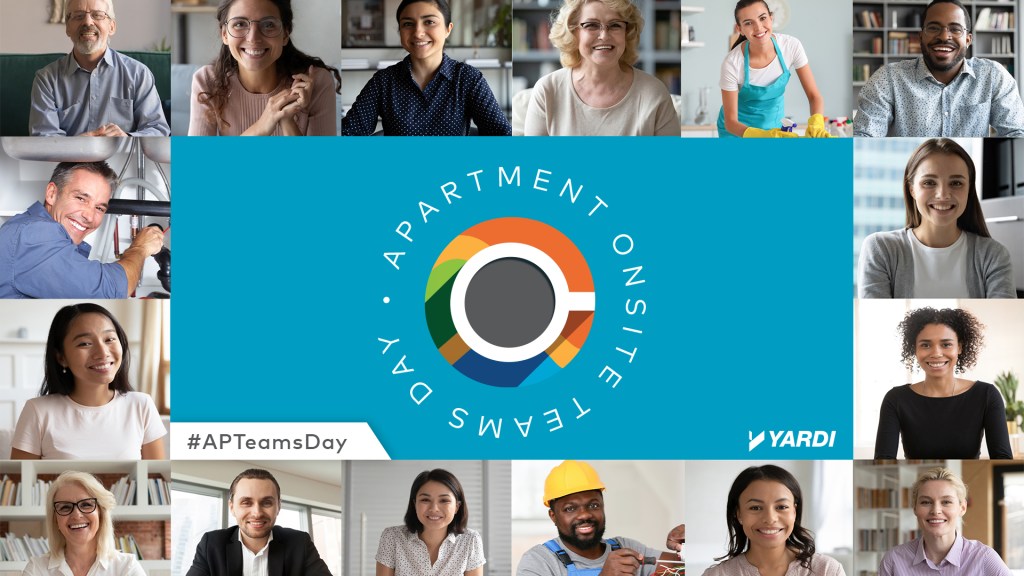There’s no way to introduce an article about the changes wrought by 2020 that doesn’t underplay the significance of the COVID-19 pandemic. It’s affected the way we do everything — limiting travel, increasing screen time and turning even the most basic activity into an exercise in risk management. For people in the multifamily industry, apartment rentals went from a typically high-touch experience to virtually contactless, seemingly overnight. And while some of the changes are only temporary, others are likely to last long after the virus abates. “This year is a pivotal moment that will reshape how we do business,” asserts Esther Bonardi, vice president of marketing here at Yardi. “The pandemic is changing our future. How can we use this for good?” Bonardi recently had the chance to talk with three multifamily leaders about their experiences marketing and leasing apartments during the pandemic. Hear from Garin Hamburger, senior director of national marketing at Pinnacle; Ian Mattingly, president of LumaCorp Inc.; and Pei Pei Mirabella, senior vice president of operations at Bozzuto on the emerging trends that will have the biggest impact on multifamily rentals going forward. Bonardi: What do you think was the biggest change in 2020 that has the most potential to become a permanent shift in the way we do business? Hamburger: The biggest change that will last through the pandemic and continue to evolve after it are the creation of alternative tour types, specifically virtual and self-guided tours. I really believe we’re coming into an age where technology will dramatically shift the customer journey and the leasing agent experience. Mirabella: The companies faring better during abrupt shutdowns have the tools and technology in place to pivot operations and enhance productivity while working remotely. In addition to using live and pre-recorded virtual...
Tips for Hosting + Staging
Virtual + Self-Guided Tours
If you thought that virtual tours and self-guided tours were flashes in the pan, think again. Renters throughout the U.S. are speaking up about their tour preferences. Non-agent-lead tours are ideal for more than 52% of renters, reports a survey by RentCafe.com. That same report reveals that more than 83% of renters would take a self-guided tour. Though social distancing is a factor for some, 63% of renters would do so because they want to tour at their own time and pace. Additionally, more than 70% of renters would rent an apartment without seeing it in person if they could explore it via virtual tour. Virtual and self-guided tours offer convenience as well as safety. Since convenience is always trending, these tour types are here to stay! Check out the pro tips below to host effective virtual and self-guided tours. Special camera considerations for virtual tours Property photographer Deanna Campana of Welcome Home encourages agents to conduct tours in landscape mode (horizonal) rather than portrait (vertical). “The latter will make all your spaces seem narrow and cramped,” she explains. Campana notes that time of day is also important. During a conventional tour, you may choose to tour midday, open all the blinds and let the natural light cascade into the room. When walking from space to space during a virtual tour, however, this will cause your camera to fade between very dim and bleached-out spaces. The results are a tour that’s challenging to see, much less enjoy. “Midday light is too harsh,” warns Campana. “Consider scheduling most video tours in the early morning or evening light. Cloudy days are ideal so you can shoot at any time.” She adds, “If you must tour midday, close the blinds. The outdoors will be overexposed, too bright for renters to see what’s out there, anyway. It’s better to focus on what’s inside.” She advises treating the view from each room as its own feature when necessary. Go outside when you can. If not, approach the window, open the blinds, and close them once done. When light distortion is unavoidable, schedule in the evenings during “golden hour” when the light is “soft, magical and with a golden glow.” “Many phones will allow you to snap pictures while recording,” says Campana. “Take pictures of things the renter likes. You can include them in your follow-up email.” Live vs. pre-recorded tours Pre-recorded tours are a great option. About 27% of renters said they would prefer to see prerecorded videos of units over live virtual tours, reports Adobo listing site. Once posted, pre-recorded unit tours are available 24/7 on your website, which saves time for staff. A videographer or component agent can pick the ideal time of day for the best lighting and noise control. Image stabilization tools create a beautiful, smooth tour and less hassle for staff. For agents taking on the challenge, Campana adds, “For pre-recorded tours, shoot the video at night using ambient light. It’s uniform, flattering and won’t cause troublesome light imbalances.” Since pre-recorded tours require editing, they may not be ideal for hot markets where units are listed and leased in a matter of hours. Other considerations for pre-recorded and live virtual tours Pace matters. Walking too quickly through a unit will cause renters to feel rushed and possibly dizzy and disoriented. “Walk slower than you think you need to, like you’re walking with a senior,” smiles Genitra Maxwell, assistant manager at Bridges of Kennesaw apartment community. “And just check in and ask if the pace is okay.” Leasing agents may be accustomed to narrating conventional tours. Too much talking may seem distracting to some. “Just ask them what they prefer,” advises Maxwell. “Some may want a narrated walkthrough and then silence during the second pass where they can ask questions.” Maxwell encourages agents to home in on details that renters won’t see a camera phone. “Any technology in the unit,...
Amenity Reset
For Multifamily
Amenities can be the irresistible lure that persuades apartment searchers to choose one community over another. Rooftop pools, fitness suites, concierge package service, housekeeping, business centers and dog wash stations all have devotees. “Over the past several years the multifamily asset class has been engaged in an amenities war, with projects offering better and more luxurious add-ons in order to draw in residents,” GlobeSt.com reported in April 2020. But COVID-19 prompted some apartment residents to rethink what matters to them, which in turn forced owners and managers to reevaluate their offerings. “Everybody is really searching for creative solutions right now,” Jeremy Brutus, co-founder of gym facility management company Urbn Play, told the New York Times in September. “I don’t think amenities will ever go back to the way they were before,” added Whitney Kraus of New York residential sales and leasing specialist Brown Harris Stevens Development. Several of the most common changes are fairly unobtrusive, such as lounges repurposed as schools, limited capacity in common areas, clubhouses divided into separate rooms, movable couches, touchless key fobs, cordoned-off work and recreation areas, and mandatory reservations for facilities. Package delivery and storage services and HVAC upgrades to make interior air cleaner are also in greater demand, according to Rick Haughey, vice president of industry technology initiatives for the National Multifamily Housing Council. Some communities have even swapped steel handles on barbells, weight machines and other equipment for copper, which is more expensive but harbors the coronavirus for a shorter time. Apartment communities on the high end of the rental scale, such as New York’s Madison House, can get even more creative with members-only primary care and emergency medical service offerings. Sollis Health, which services the building, says 50% of its business is house calls made by...
Remote Onboarding
Best Practices for Property Management
Working from home, remote work, telecommuting: whatever you call it, it’s a challenge for property managers across the nation. If you’re lucky enough to be hiring in during the pandemic, you’re also facing the challenge of onboarding in a remote work environment. It’s not easy. With the right tools, however, you can onboard new team members with ease and efficacy. Check out these recommendations from industry experts for remote onboarding, simplified. Just when you thought property management couldn’t get any harder… Property management is a notoriously tough business. The National Apartment Association reports an average turnover rate of 33% in 2019. The highest rates are for leasing and maintenance, at 31.9% and 39.2% respectively. With each vacant position comes the time and money spent on marketing, hiring and training. The time it takes to train a new employee varies. It’s safe to say, though, that hours spent training a revolving door of new hires isn’t an ideal use of your team’s time. When translated to dollars, it costs between $5,505.80 and $9,444.47 per turnover to replace an entry-level employee. High turnover is costly, time consuming and counterproductive. Then a pandemic arrives that complicates everything for everyone everywhere. Property managers who are lucky enough to hire must now do so without interviewing or training applicants in person. Teams attempt to build office culture and support with the same screens used for work and productivity. A career path that deters 33% of employees each year now faces additional challenges. Fortunately, robust e-learning software is here to help. What methods can help property managers overcome these challenges? Begin with the cloud. Cloud computing empowers property owners to implement e-learning and remotely train new hires. The system facilitates real-time collaboration between participants on documents and projects. Additionally, software that operates on integrated and centralized cloud storage is advantageous to a piecemeal assemblage of programs. Patricia Pomies is chief delivery officer at Globant, an innovator in workplace efficiencies. The cloud is a powerful tool because it provides 24/7 access to learning content. Remote, easy access is key for distance learning. “Their approach should be focused on promoting a culture of continuous learning, and training programs should live in one central, digital location for employees to access easily,” says Pomies. “It’s also best to give employees access to different learning experiences and training based on their time, interests, level and expertise—whether they are a remote employee or not.” Create online trainings that are branded and customizable. Consider a remote learning platform that enables branding and customization. Since your new hires won’t go into a physical office each day, it is essential to use branding to instill a sense of place and company culture. Customization ensures that your messaging within the e-learning platform is consistent with corporate messaging. Of equal importance, you will be able to customize learning modules based on the new hire’s role within the organization. This ensures that new hires can prioritize and specialize as needed. Customized content also encourages the most engagement from participants. Jim E. Guilkey, author and doctorate in instructional design and learning strategy, suggests that engagement improves problem-solving skills. In an interview with Society for Human Resource Management, Guilkey encourages clients to explore engaging options such as virtual collaboration rooms and role playing. “Instead of simply lecturing, put the impetus for learning on the learners,” he says. He recommends putting students in a virtual collaboration room to evaluate real and hypothetical situations pertinent to their roles. Together, they can analyze, troubleshoot and propose solutions and improvements. Rather than relying on industry standard, pre-set modules, customized courses provide hyper-local learning opportunities. Presenting scenarios specific to the brand, property or region create a stronger sense of place and culture for remote learners. Check for comprehension before assessments and analyze assessment data for additional learning opportunities. When teaching in person, an instructor can use body language to gauge whether content is “sinking in”...
Looking at Liability
Protecting your property
As public health restrictions lift, many homes are welcoming loved ones, guests and clients again. The influx of visitors may have you second guessing your renters insurance policy. If you’ve wondered if you’re liable for COVID-19 transmitted while in your rental, read on. What is the “liability” part of your renters policy? Liability insurance is a specific field of coverage on your renters insurance policy. It protects you, the purchaser, from the risk of liability resulting from legal action. Such legal action may pertain to bodily injury or property damage that guests experience while at your home. When we think about liability insurance for rentals, slips and falls come to mind. If someone delivers a mattress to your house, trips and falls over an extension cord in the hallway, that’s a matter for your liability insurance. But what happens when the threat is unseen? Hundreds of flu seasons have come and gone since the advent of renters insurance. Few people, however, considered their liability if someone contracts an infectious disease while in their rental. Infectious diseases such as the common cold, flu and COVID-19 may cause bodily harm, but they are treated differently under liability insurance provisions. The liability of disease is a contentious topic: to what degree can a property owner or tenant protect occupants and guests? What measures are they required to take, legally or ethically? How precisely could guests pinpoint the exposure to the rental? Answers will vary, but for nearly all renters, your liability is limited. The majority of liability clauses in renters insurance policies contain virus and pathogen exclusions. This includes liability, loss of use and personal harm due to exposure to a virus. Consider these CDC guidelines for guests visiting your community. Does remote work influence my liability...
5 Fun Holiday Ideas
With social distancing in mind
Social distancing and partying don’t seem to go hand-in-hand. With a little creativity, though, you can host fun holiday events for your community while honoring safety protocols. Check out these five fun holiday party ideas that add value, encourage a sense of community pride and resident loyalty. Themed partner yoga party The first step in hosting a successful partner yoga party is to select the location. Warmer locations (ahem, southern states) may still make use of their tennis courts and other outdoor spaces. Cooler climates may consider their roomy community club or renting space in a local brewery or event center. You’ll want an area that is spacious and level. Once you decide where to host your partner yoga party, the rest is super simple! Contact a local yoga studio and request a private teacher for your event. The teacher should be familiar with the basics of partner yoga or acro yoga. Once the details are set, have residents register via the community concierge. Encourage residents to find a same-household partner and dress in holiday-themed activewear. (Cozy holiday pajamas would work, too!) On the day of the event, divide your space: every ten feet, leave a sticker, party favor or other marker. That will let duos know where to place the center of their mats. Then the experienced yoga teacher can guide pairs through safe yet fun postures that encourage teamwork, communication and laughter. If you charge for the event, consider donating a portion of the proceeds to a local nonprofit. #ShopLocal wine + beer tasting Collaborate with a local wine shop or brewery for this unique spin on bar hopping and wine tasting! Many local shops offer tastings that encourage clients to experience new brands or unique beverages. You can replicate the experience...
APTvirtual
How we connected
The apartment industry met online at APTvirtual, powered by NAA, from Nov. 2-6 to forge more powerful connections with each other and the technology that will take us forward as we stay connected at home. With the theme “Yardi keeps you and your residents connected” we were there to share, learn and spark inspiration together. What we shared It was a pleasure to not only hear your voices but also see your faces, including through the virtual mosaic that allowed attendees to be together in spirit. Thank you for sharing your photos to help build this fun digital community — look closely to find your friends and colleagues. How we learned We hope you joined our educational sessions, but if you missed them and were a registered attendee, you can watch them on demand until Dec. 4. Big Data, Benchmarking and Forecasting: A Tale of Two Studies With advances in big data, machine learning and artificial intelligence, the ability to manage your business with laser precision and shape future outcomes has never been greater. In this session, industry leaders share how they use operational benchmarks to identify opportunities and predictive analytics for marketing and leasing to make timely changes and realize gains. Here are a few sound bites: “Using machine learning, we’re able to pick out patterns and trends in a much broader pool of data. We have lots of data points, including around spending on SEM and how it correlates to leasing ratios. Seeing the data reinforces decisions about when to spend marketing dollars to meet our leasing and revenue goals,” said Shawn Cardner, executive vice president at Grubb Properties. “Our asset management team takes a very active role in the budgeting process, and benchmarking is extremely important to them. Being able to look at a region and do comparisons — down to spending on plumbing and landscaping — gives us visibility down to budgeting line items,” said Joe Anfuso, chief financial officer at MG Properties. Emerging Issues: Looking Ahead to the Post-Pandemic Future Even as we deal with ongoing economic and societal impacts from the COVID-19 pandemic, we are all thinking about what the future might look like. Universal truths for our industry will persist: people will still need to rent apartments. “What we’re seeing from our RentCafe.com surveys is that renters want more choice with self-guided and virtual tours. I think these options for more convenient touring will persist long after the pandemic,” said Esther Bonardi, vice president of marketing at Yardi. Bonardi was joined by Garin Hamburger from Pinnacle, Pei Pei Mirabella from Bozzuto and Ian Mattingly from LumaCorp to share forward-thinking ideas for multifamily’s post-pandemic future, including marketing and leasing. Where we talked tech Thanks for visiting our booths to chat with Yardi experts and tell us what you’re excited about! Big data and self-guided tours are leading the way into 2021, and according to our polls, 69% of respondents are most excited about self-guided tours. Asset IQ, part of Yardi Elevate, uses big data to deliver predictive analytics and prescriptive actions to lower costs and increase revenue. RentCafe Self-Guided Tours helps operators meet the demands of a changing market, giving prospects the ability to tour at their own pace and maintain social distancing. Booth visitors also learned about RentCafe Chat IQ, an AI-powered chatbot that learns and adapts to fit each community. Who we met We hope you enjoyed hearing from Anant Yardi himself during the Connect with Yardi Executives session. In addition to talking about the state of the industry and tech trends, Mr. Yardi said, “Relationships with our clients are so important to us. I’m looking at all of you and so many memories of working together over the years are coming back. Thank you for dedicating your time to this.” How to connect with us now Missed us at APTvirtual? Contact us, and we’ll show you what you...
Multifamily Movement
Yardi Matrix updates industry trends
The number of Americans who have moved since February 2020 wasn’t unusual compared to typical U.S. mobility trends, but there has been a distinct shift in where they are relocating, according to the latest Yardi Matrix multifamily webinar. In brief, big urban cities like New York, Chicago, San Francisco and Miami are out, while second tier markets and tech hubs like Austin, Kansas City, Sacramento and Boise are in. “What we really have seen is a movement of people that is different from what we have seen in the past,” said Jeff Adler, vice president of Yardi Matrix, who delivered the analysis. A webinar on the commercial real estate market with valuable insight for that sector will take place on Wednesday, Nov. 11. You can register here. The Nov. 4 multifamily session, which is now available to view on demand, summarized the trendlines for the apartment market nationwide. It has been relatively resilient despite the economic fallout caused by the COVID-19 pandemic. For example, in the month of October, 94.6 percent of apartment households had paid rent as of Oct. 17, according to NMHC’s Rent Payment Tracker. However, small owners and managers of less than 50 units are suffering. These owners typically hold small balance loans, or SBLs. “Because SBLs are typically used to finance apartments with less than 100 units, each resident that has trouble paying rent has a more significant impact on the property’s cash flow,” stated the Matrix summary. The bulk of the 16 million Americans who have moved since February, though, are working from home and seeking a relocation situation that will be advantageous during the remaining months of the pandemic. They’re seeking out apartments or single-family homes where they have more space and eschewing the walkable urban lifestyle that...
Connect at APTvirtual
What Not to Miss
The apartment industry is meeting online at APTvirtual powered by NAA from Nov. 2-6 to spark inspiration as we all stay connected at home. Once again, Yardi is proud to participate as a sponsor, exhibitor and educator at one of the industry’s most anticipated conferences of the year. And what a year 2020 has been. To ensure the long-term success of the industry, Yardi has donated $1 million to the COVID-19 Rental Housing Support Initiative, a partnership with NAA, IREM, NMHC and NARPM. APTvirtual lets attendees engage with the latest developments in the apartment industry, from business best practices to marketing strategies and leasing innovations. You’ll also hear amazing stories from this year’s Game Changer speakers to kick off each day of the event. The platform is now live, so it’s an ideal time to start planning your schedule. We’re excited to meet you there. Not registered yet? Use discount code APTvirtual200 for $200 off. Connect with Yardi: Enter to win! While our technology helps you and your residents stay connected at home, our various activities at APTvirtual help you connect to the NAA community — and enter to win a major giveaway for a new at-home experience! First, submit your conference photo to the Virtual Mosaic. It connects digital threads from all over the country that you can watch come to life as a collaborative, branded image. Then, make time to visit with us. We have four virtual booths setup so you can connect with the technology most applicable to you: Yardi for all things operations and big data, Yardi Breeze for simplified property management, RentCafe for marketing and Yardi Matrix for market research data. Engage with us in our virtual booths using the links below and get a Starbucks® gift card to enjoy coffee on us, plus enter for a chance to win more. More ways to engage: Tech you can’t miss! Come to the Yardi booth and “Connect with Yardi executives” for a special discussion happening on Thursday, Nov. 5 at 1 and 1:30 p.m. EST (two consecutive sessions). Anant Yardi will be there to answer your questions and share insights along with Esther Bonardi, Terri Dowen, John Pendergast and Chris Ulep. During the daily expo hours, visit us to connect with experts on the newest solutions for multifamily operators. You’ll have a chance to join our breakout rooms on marketing, big data and operations to ask questions and hear from our top innovative experts in the industry. Let us show you why big data is a big deal with Yardi Elevate, including Asset IQ for predictive and prescriptive insights with benchmarking, Forecast IQ for expediting accurate budgets and new Maintenance IQ for shortening unit turns. Do you have the right technology to meet the needs of today’s renters? Join us at the RENTCafé booth for innovative solutions to ensure your properties are ready to meet the demands of a changing market. Give prospects the ability to tour at their own pace and maintain social distancing with RENTCafé Self-Guided Tours. Also, get up to speed with RENTCafé Chat IQ, an AI-powered chatbot that learns and adapts to fit each community. Stop by and we’ll show you a chatbot designed specifically for you. At the Yardi Matrix booth you can learn how to utilize market intelligence to identify value-add investment opportunities. Newly added estimated DSCR and LTV data helps you easily find distressed properties, benchmark current performance and plan future financing decisions. Schedule a personal demo to see this new data set. We’d also love to show you Yardi Matrix Student for insight into purpose-built and shadow market properties surrounding over 1,000 colleges and universities across the U.S. Visit the Yardi Breeze booth to see why thousands have switched to our refreshingly simple property management platform. Breeze offers everything you need to market and manage your portfolio from anywhere, on any device. Simple pricing and convenient monthly...
Reputation Management
5 Ways to Stay on Top
In the age of online everything, it takes a lot more than a good website to stay on top. Ratings and reviews are the new “word of mouth” for multifamily properties, so it’s critical to proactively monitor and protect your online reputation. Here are five reputation management strategies to make sure your communities get the attention of potential renters for all the right reasons. Claim your local listings and review profiles No, we don’t mean your vacancy listings. Local listings refer to every mention of your business on the web. According to BrightLocal’s 2019 Local Consumer Review Survey, 90% of consumers used the internet to find a local business in the last year, with 33% looking one up every day, so claiming your online listings and review profiles are more important than ever. To appear in local results for searches like “apartments for rent in [your city],” you must make sure your business name, address and phone number are consistent across every website. This is sometimes referred to as your NAP (Name/Address/Phone). In an article for Marketing Land, research director Pamela Parker asserts, “It is critical to claim your local listings by providing accurate information to search engines and online directories (namely Google, Facebook, Apple Maps, Bing and Yelp) … Claiming your listings also gives the site publisher a direct, verified relationship with your organization. It establishes your brand as the listing’s owner and gives you control over all content and updates.” It’s important to remember that claiming your listings isn’t something you do just once. You should schedule annual or biannual audits to make sure your business profile remains up to date — and that no one has added inaccurate information. Ask for reviews If you’re listed on a review site, but don’t have any reviews, potential renters will likely pass you over for a competitor with more and better ratings. BrightLocal found that the average consumer reads 10 reviews before trusting a business and visiting your website. But incentivizing reviews is frowned upon by the big players, like Google and Yelp, and most consumers say they can spot a fake review. So how can you get more authentic, positive reviews more quickly? Award-winning marketer Drew Davis shares the secret in this episode of Moments of Genius. Reply to reviews We’ve all been told that we should reply to every review. But does anyone read your responses? In a word: yes. The same BrightLocal consumer review survey discovered that 97% of people read businesses’ responses to reviews. While it’s nice to respond to positive reviews, renters are looking closely to see how you respond to negative reviews. Are you aware of the issue? Did you try to resolve the conflict or offer a solution? No matter how inaccurate or unfair you feel the review is, it’s important to show empathy. Read more tips for responding to negative reviews. Monitor the competition Ever wondered what people think about the competition? Now it’s easy to find out and see how you stack up. Read competitor reviews to see what renters like and don’t like about their properties. Then, use that information to level the playing field or even get ahead. For example, if you find out that renters love the neighboring property’s amenities but don’t feel a sense of community, you may want to update your website to highlight those elements. You could add amenity photos and pictures of community events as well as a calendar showing virtual and in-person activities available to your residents. Analyze customer sentiment While reading (and responding) to every review is key, it’s also important to keep an eye on the big picture. Gathering feedback in the form of online reviews is pointless if you’re not analyzing customer sentiment to strategically promote change. Sentiment analysis often goes beyond star ratings to identify specific keywords that with positive and negative connotations, giving you more insight into...
Yardi + AIM
Live webcast Sept. 17
Are you missing live events? While we can’t bring back the hum of the tradeshow floor just yet, we’re excited to team up with AIM to host a live webinar event that we hope will rival some of your favorite speaking sessions from conferences past. Keep reading to see how we’re bringing industry leaders from Bozzuto, KETTLER and The Management Group together on one virtual stage … and why you want to reserve your seat asap. The New Apartment Marketing Playbook: Consumer Behavior Has Shifted, Have You? Thursday, Sept. 17, 11 a.m. PDT Even as the COVID-19 pandemic continues, renters are still on the move. With social distancing measures in place, renters expect to interact with properties in new ways. This increasing demand for virtual and contactless engagement is nothing new. But now that we’ve adapted to a new norm and the virtual conveniences that come with it, there’s no going back. Considering this shift in consumer behavior, here are some questions your property management teams may be facing: Is it possible to create an online experience as powerful as a visit to your properties? How can you offer game-changing online and self-service tools that don’t compromise your security standards? What should your leasing agents be doing to pivot and provide real value in an increasingly virtual world? “Don’t lose customers to your competitors while you’re waiting for things to ‘get back to normal.’ Normal as we knew it is changing. Taking this opportunity to make smart updates to your leasing process will have a lasting positive impact on your business in the months and years ahead,” said Esther Bonardi, session moderator and vice president of marketing at Yardi. During this live online event, you will learn how to: Convert more renters by creating authentic experiences onlineLease more units by offering a range of tour types to fit every needImprove the prospect experience while prioritizing the safety of your team and propertiesEvolve leasing positions to meet the demands of the new customer experience Speakers include: Jamin Harkness, Executive Vice President, The Management GroupKelley Shannon, Senior Vice President, Marketing & Customer Engagement, BozzutoDaryl Smith, Senior Vice President & Chief Marketing Officer, KETTLER Free ebook Webinar registrants will receive a free copy of The New Apartment Tour with their confirmation email. This exclusive ebook details three ways you can modernize different tour types at your properties to convert more renters, both online and in person. Save your seat today to get your...
Make Ready Solutions
Increase NOI and Revenue
When was the last time that you reviewed your unit make ready process? During difficult financial times, it is essential for multifamily managers and owners to cut overhead costs and improve efficiencies in every area of business. You could notably improve portfolio valuation by optimizing how you turn a unit. Yardi caught up with Jennifer Price, director of systems at Walton Communities, to dissect and interpret the latest in multifamily make ready data. Our experience reveals how web-based technologies reduce unit turnover costs and promote efficiency. Economic downturn prompts research into cost-saving measures For property managers and owners, efficiency matters more than ever. The U.S. economy is currently in recession, and multifamily market data for summer 2020 reveals negative rents in the second quarter. This is the first prolong quarter of negative rates since the aftermath of the global financial crisis. Rents drops aren’t expected to rebound until 2021. In multifamily housing, spring is normally a time for growth. Most markets would experience rent growth of about 2% in the second quarter alone. At the end of the first half of 2020, however, rents fell 1.8% year-over-year for luxury lifestyle units. Working-class renter-by-necessity units were only up by 1.4%. Additionally, occupancy rates dropped 30 basis points nationally to 94.4% through May. Analysts forecasts that occupancy rates will continue to decline. A typical multifamily portfolio consisting of 10,000 units will turn 30%-50% of their units each year. Unit turns require a sense of urgency: getting the unit back on the market means restoring cash flow and cutting vacant unit losses. When the turn process is inefficient, however, the portfolio may experience between $2 million to $3 million of NOI losses, or about $40 to $60 million of potentially unrealized asset value, states a recent report...
Apartment Onsite Teams Day
Celebrating Essential Workers
We’re excited to participate in the first Apartment Onsite Teams Day on August 12, 2020. The day has been designated by the National Apartment Association at the request of industry leaders to recognize onsite property teams throughout the country for their work to keep people safely housed during the COVID-19 crisis. Celebrate onsite workers Apartment Onsite Teams Day recognizes the people who have helped guide apartment communities throughout the U.S. through this unprecedented and uniquely challenging event. “With the advent of the coronavirus pandemic, our onsite management teams became our first responders. On this special day, we want to take the opportunity to express our gratitude for your leadership, your sacrifice and your care of our residents, our teammates and our clients,” said Mike Holmes, president of Easlan Management and NAA chairman. “The fight must continue, but we want to set aside a day to let you know how much you are appreciated. We all stand with you.” Nominate your heroes NAA has compiled an Apartment Onsite Teams Day toolkit to help property management companies thank their teams on this day in a variety of ways, from social media posts using the #APTeamsDay hashtag to safe, socially distant parties. Here at Yardi, we’re amplifying the celebration by inviting everyone to nominate onsite team members that are making a difference. It’s easy to participate. Simply grab a screenshot of the graphic below and fill it out. Or just retype it in your own words. Then post it on Facebook, Twitter, Instagram and/or LinkedIn. You must use the hashtag #APTeamsDay and tag Yardi to enter. Five winners will be selected at random on Friday, August 14. Winning posts will receive two $25 gift cards. One will be sent to the post creator, and the other will be sent to the person or team they nominated. It’s a nice way to do a little something extra for those supporting the many renters spending more time at home this year. “The apartment industry’s onsite team members have been on the frontlines throughout the COVID-19 pandemic, committing themselves to performing the vital work necessary to keep the community together during these trying times,” said Esther Bonardi, vice president of marketing at Yardi. “We invite you to join us in promoting the amazing work of our onsite teams.” We encourage you to get creative when showing appreciation for the people in your communities who have gone above and beyond. Add photos or videos and encourage your residents to participate too. We’ll be resharing some posts starting now through the end of the contest. Stay tuned It is our hope that Apartment Onsite Teams Day continues in the years ahead to applaud the ongoing commitment of onsite teams who work hard to keep residents happy and properties running smoothly. Don’t forget to give a shoutout to your favorite #APTeamsDay heroes for a chance to win! We look forward to highlighting your submissions on our social platforms throughout the week. See complete contest...
Relocations + Rent Drops
COVID-19 Prompts Migration
Already apparent in the U.S., COVID-19 has resulted in a migration from major cities and falling rents. As the housing industry braces itself against continued impacts from the virus, will both trends continue into the third quarter? Market analysts, real estate agents and renter surveys give us clues about what to expect. Are people really moving away from cities as a result of COVID-19? Yes. People are leaving cities to avoid COVID-19 risks and disturbances. Though it is a misconception that population density equates to higher risk, perception matters. The perceived increase in risk has made city residents feel less safe. That fear, coupled with other disruptions, motivates relocation for those who can afford it. Pew Research Center reports that 3% of U.S. adults moved due to the pandemic and about 6% had a member of their household relocate. Of those surveyed, 28% moved to reduce their risk of contracting the virus and 8% moved due to job loss. About 20% moved to be closer to family. Younger people make up a unique portion of those who relocated. Roughly 9% of adults ages 18-29 relocated due to the virus. This includes 23% of respondents who were university students forced to vacate their campuses. Even New York– the market trendsetter that has captured hearts for generations– is seeing mass movements to the nearby suburbs. Real estate agents Susan Horowitz and Monica Schwerberg explored the details in an interview with NPR. “We are seeing 20 offers on houses. We are seeing things going 30% over the asking price. It’s kind of insane,” Horowitz said. “It is a blood sport.” She adds, “Every last bit of it is COVID-related.” Schwerberg agrees, “In the month of April, where we typically would get maybe 75 inquiries in a month, we had over 400 inquiries.” People who once loved the city atmosphere are seeking locations with less population density, which is falsely assumed to correlate with increased infection risks. Additionally, many breadwinners are now working from home. Remote work opportunities have made commute times less of a factor in housing decisions. Since March 2020, about 10,000 New Yorkers filed for address changes to the state of Connecticut alone, reports Hearst Connecticut Media. Nationwide, U.S. Postal Service data indicates that southern Florida and southern California are popular relocation destinations. Who is moving during COVID-19? While some people are relocating due to job loss and financial difficulty, there is a correlation between job security, higher incomes and relocation. In short, households with higher incomes can afford to sell their current home (potentially at a loss) or terminate a lease early in favor of getting a new home in the suburbs. Higher income households are also more likely to have remote work. The ability to maintain income while working from anywhere permits the flexibility needed to relocate during the pandemic. Additionally, higher income households represent the demographic most likely to own a vacation home. About 13% of those who relocated moved into their second home or vacation home, reports the Pew survey. How does COVID-19 relocation impact the rental market? Yardi Matrix analyzed asset performance data from 107 major metropolitan areas between April and May 2020. During that time, multifamily rents declined by .4% nationwide. Overall, twice as many markets witnessed rents decline than rents rise. “Multifamily’s nearly decade long run of healthy performance increases came to an abrupt and unexpected end this year,” said Jeff Adler, vice president of Yardi Matrix. “Job losses have been particularly high among apartment renters, and simply collecting rents and maintaining occupancy is a new area of focus for owners and managers.” The report suggests that the pandemic’s influence on work conditions, public health metrics and social trends will continue to impact the housing marketing for the next several years. “If renters decide to eschew urban apartments for a more distanced standard of life in the suburbs or smaller cities, multifamily could...
Market Upsides
Maximizing potential as coronavirus continues
Even before the COVID-19 pandemic, multifamily market experts were talking about preparing for big economic changes. Now that rising unemployment rates, benefit delays and social distancing have created new challenges for real estate managers and renters alike, it’s time to re-think every aspect of your operations. Here’s some good news: there are real upsides to the downturn, including opportunities to move business online and improve communication to form stronger relationships with your customers. Read on for five key takeaways from Yardi’s operational strategies webinar that can help you right now and into the future. 1) Maximize marketing websites Apartment searches are on the rise and units are being rented sight unseen — and it’s all happening online. How can you keep up? Provide a virtual marketing and leasing experience from start to finish. Make sure your websites provide plenty of curb appeal for your listings, and include optimized photos, videos and 3-D floor plans along with virtual meeting and tour options. Offer live chat to answer questions from prospects and consider a chatbot when your agents are unavailable — a “contact us” email address or web form isn’t enough anymore. Use nudge marketing campaigns and page narratives to help prospects make timely rental decisions. And this is critical: bring your entire leasing process online from application to self-screening to lease execution with an electronic signature. Are you providing unit touring options? If you’re not offering self-guided tours yet, in this new world of contactless marketing it’s a great way to sign more leases. Even before the pandemic, self-guided tours were growing in popularity, and now they are a must to ensure social distancing and a contactless experience for your staff and customers. It’s important to plan for self-guided tours at the site level including the ability to verify prospect identities remotely before allowing access to your units. With COVID-19 concerns, you’ll also need a strategy for cleaning and sanitizing units after every visit. Once you figure it out, you’re likely to reap the benefits of agentless tours. 2) Consider strategy changes Take a good look at your marketing spend and identify which channels have provided you with long-term contracts and where your new opportunities are coming from. With a growing number of prospects willing to rent a unit sight unseen you need to take advantage of contactless opportunities. Ramp up your targeted marketing to those socially distant customers with a clear message about your easy online leasing process. Once you drive that motivated traffic to your website, those prospective renters can enjoy all the good stuff covered above including around-the-clock applications and leasing. 3) Send the right message Now is a great time to build stronger relationships with your residents. More than ever, communication with customers and within companies is critical. Be sure that your content, messaging and tone are not only aligned with your brand and our current reality but also resonate with what people really care about. We all need to feel safe and supported, and multifamily managers are in a unique position to create an inclusive and positive community for staff and residents. You can offer residents who are struggling financially payment plans and deferral options. If you haven’t accepted credit card payments for rent in the past, maybe now is the time to allow it to help keep your payment percentages high. There are also the day-to-day messages you need to push out to make sure your social distancing policies are followed when common areas and amenities are used. You will most likely see a big difference when it comes to renewing leases and keeping quality residents for the long term. 4) Reduce leasing risk With high unemployment and apartment fraud on the rise, you need to be sure you know exactly who you’re renting to. That doesn’t mean that prospects who are short on cash won’t be quality residents, so you’ll want to screen...
Long Term Impacts
New Yardi Matrix Report
With the U.S. economy in a recession, unemployment numbers sky high and COVID-19 cases surging in the south and west, multifamily owners and operators face challenging times ahead. And things may get worse before they get better, according to a new special report from Yardi Matrix. The report is based on a study of 107 major metros, with data reflecting April and May 2020 asset performance. Over that period, multifamily asking rents dropped .4% nationally, and twice as many markets saw rents decline as opposed to increase. Renters are looking for less expensive units, with the biggest impacts in the sector felt by Class A+ properties. Rents for “luxury lifestyle” properties dropped by -1.2% over the last two months, compared to a decline of .5% for “renter by necessity” properties. “Multifamily’s nearly decade long run of healthy performance increases came to an abrupt and unexpected end this year,” said Jeff Adler, vice president of Yardi Matrix. “Job losses have been particularly high among apartment renters, and simply collecting rents and maintaining occupancy is a new area of focus for owners and managers.” Multifamily had a long run of strong performance – asking rents grew by 26% nationally between January 2015 and 1Q20. But going forward, the future looks cloudy at best. “The shape of the recovery remains unclear. More importantly, the pandemic is spurring changes in working conditions and social trends that will impact housing demand for years to come,” states the report. What’s ahead will be determined by a complicated combination of economic factors, public health metrics and renters’ feelings about the future. If renters decide to eschew urban apartments for a more distanced standard of life in the suburbs or smaller cities, multifamily could be in for a prolonged pain period. Gain...
Warm Social Distance
Today’s Welcome Packages
Virtual and self-guided tours have helped numerous property managers fill a lease up during social distancing. When it comes to welcoming new residents, though, creativity and agile software make it possible to maintain space without seeming distant. Personalization is essential Personalization is a key element in helping new residents feel welcomed. These days, many of the best practices for personalizing welcome packages still apply. They simply require a bit of creativity to implement while keeping space, health, and customer satisfaction at the forefront of welcoming efforts. Leasing agents can assist welcoming committee members with helpful tips about the new residents. When your marketing and leasing platform integrates with your property management software, the notes that you put in prospects’ files easily transfer to resident files! Note pet ownership and areas of interest such as container gardening and DIY crafts. Your notes can inform the types of gifts included in each new resident’s welcome package. Remember: thoughtfulness makes a greater impression than price! Even when you can’t greet new residents face-to-face, the thoughtfulness and personalization of your welcome package can speak for you. Local treats delivered Since COVID-19 precautions required businesses to limit on-premises operations, delivery features have become a necessity. Many locally-owned small businesses that did not invest in delivery services have implemented them in recent months. The shift to delivery works in your favor. Include gift cards and discount vouchers in your welcome basket. Gifts from locally-owned shops and restaurants have an even stronger appeal. Every transaction is vital to small businesses. Your patronage demonstrates your efforts to support entrepreneurs in the community while giving residents a preview of the hyper-local treasures in the neighborhood. Use your online concierge platform as a delivery system for your welcome packages. Notify residents when the package...
Reopening Multifamily Amenities
Tools and Tips for Property Managers
It has been about four months since U.S. multifamily communities restricted access to amenities like gyms and swimming pools. You’re likely eager to resume offering the stellar features that helped build your community brand. (Your residents are probably antsy, too!) As shelter-in-place restrictions lift, you may be unsure how to reopen those amenities with ongoing social distancing. It’s a valid concern, but we’re here to help. In this post, we’ll explore tips and tools for reopening your community amenities and public spaces. Before reopening your amenities Start by creating a reopening plan. The National Apartment Association (NAA) released recommended best practices for reopening amenities at multifamily properties. Along with those best practices, consider that a single reopening plan may not work for all properties, even those within a portfolio. It is important to customize a plan for each property so that directives align with the relevant guidelines issued by national and local health officials. You will also want to review your liability insurance policy and update it with pandemic provisions. Many insurance providers and legal institutions offer helpful customizable templates. Communicate these updates and obtain compliance signatures from property managers, vendors, staff and residents. Watch this webinar to learn how LumaCorp and Gables Residential navigated the reopening process. Preparing maintenance staff and vendors for reopening Your maintenance staff will be working double duty. You may even need to expand your maintenance team. Keep all team members on the same page with the latest cleaning schedules and updates using a mobile maintenance app. Yardi Advanced Maintenance provides the tools that you need to assign tasks, track and supervise your site’s schedule. Manage all preventive, routine and emergency maintenance within a single app. This tool will allow staff members to access revised cleaning schedules on the go and signoff on completed tasks without revisiting the office. Outside vendors will also need additional resources to stay up to date on revised supply and service schedules. Use a mobile vendor management system like VendorCafe to issue updates to existing vendors and onboard new vendors. You can also use the software to pay vendors, which will reduce traffic in the leasing office as well as lower printing, mailing and storage costs. Watch this video to learn how VendorCafe streamlines vendor communication and payments. Restoring full functionality to the leasing office If the community is like a body, then the leasing office is its brain. It’s the epicenter of services and sales that helps the community function. Due to its necessary function, the leasing office probably never completely closed, and that’s okay. The key now is to resume as much functionality as possible with fewer nonessential interactions. Use online payments and online maintenance requests to limit foot traffic in the leasing office. The RentCafe Resident app empowers residents to do both with a single login. The app has experienced 89% year-over-year adoption growth due to its simple user interface. You can also offer services to prospects while practicing social distancing at the leasing office. A survey of 3,000 apartment shoppers reveals that 83% of respondents would take a self-guided tour if available. Their reasons vary: nearly 60% of respondents wanted to observe social distancing. About 63% of renters want to tour model units at their own pace and 43% appreciate more flexible scheduling. Prospects can easily schedule self-guided tours online through your RentCafe marketing website. The app will automatically create a guest card and convenient customizable follow-ups. Join a webinar to learn more about the versatility and flexibility of RentCafe. You’ve got mail … and lots of packages Mailrooms have remained open at all properties, yet revisiting mailroom protocols can improve safety for occupants. Mailrooms are rarely spacious, which makes social distancing difficult for residents and mail personnel. Consider limiting the number of people who can enter the space at any given time. It may also be beneficial to close the mailroom for disinfecting after...
Avenue5 Moves Ahead
With Online Services
With the outbreak of COVID-19, the new normal of social distancing has created a big challenge for many businesses — and real estate firms are no exception. Fortunately for many multifamily operators, opportunities to streamline common business processes using online software solutions are helping to surmount challenges, while delivering unexpected benefits. That’s what Avenue5 Residential has discovered. The Seattle-based firm, which focuses on third-party multifamily property management, oversees more than 375 properties and 70,000 units in 13 states, with offices in Denver, Orange County, Phoenix, Portland, Salt Lake City, San Diego, Spokane and greater Washington, D.C. Recognized as one of NMHC’s Top 50 Managers, Avenue5 is employing digital solutions from Yardi to protect their associates and customers during the COVID-19 pandemic, all without sacrificing service or missing revenue opportunities. In order to continue serving clients and residents, collecting rents, completing work orders and maintaining site operations while following CDC and regional health recommendations, Avenue5 relies on the Yardi Voyager and RentCafe online platforms. With COVID-19 concerns requiring the company to close its property leasing offices to foot traffic, Avenue5 further deepened their focus on promoting online options to residents at the onset of the outbreak; it subsequently saw a jump in resident online payment adoption from 50% to 70% as a result. April and May rent collections were strong, and executives are optimistic about collections in the months to come. “We expect to see a long-term benefit as customers acclimate to the ease of paying online, and as our associates reduce the amount of time spent on manual processes,” said Pål Ottesen, chief financial officer at Avenue5. Ottesen also noted that moving rent payments online had reduced numerous risks associated with accepting paper checks. In order to support residents directly impacted by COVID-19, and...
Rents Drop, Prompting Concern
Industry insight from Yardi Matrix
When you think about a 0.3 percent drop in anything it hardly seems like a big deal. It’s just 3 pennies on every 10 dollars. If you are an apartment operator and that reflects the national average on rents for May compared to April, some would figure it’s something not too difficult to make up. But what if it isn’t? The three-tenths of a percent is the drop for one month, and 12x that comes to 3.6 percent annually. Quickly, that could become serious. During what would typically be the middle of prime leasing season, rents declined nationally by 0.3% on a month-over-month basis, reports Jeff Adler, vice president of Yardi Matrix. He describes that drop in rents as startling. “Is it a harbinger of things to come? A warning sign?” Adler says. “When rents being offered to new residents drop like that month-over-month, year-over-year you have to ask yourself.” Adler says current national multifamily occupancy rates are mostly steady (a good thing). And there’s no deterioration in demand as measured by apartment search activity, which is also positive. “But this is peak leasing season,” he adds. “Falling like this would be at a rather significant clip. If we see it again next month, then demand will not have stabilized. And data show this is happening to high-end apartment communities.” The steepest declines in rents on a MoM basis were seen in major gateway markets that were among the first to impose strict lockdowns. Smaller markets are not immune and have seen substantial MoM rent declines as well. For this “general rolldown” in rents, Yardi Matrix has observed year-over-year price decreases of -0.6 percent to -1 percent for houses for rent in Los Angeles, San Jose, Houston, Orlando, Denver, San Francisco and Chicago. Unprecedented Swiftness Many long-standing observers and employees of the multifamily industry can point to real estate’s cycles, and to the Great Depression, back around 2008-09, when rent declines were similar. “But the swiftness of what we’re seeing now is unprecedented,” Adler says. “Back then, job formations were slowing and you could almost read between the lines to know something bad was coming up. There were signals. This time, it’s sudden. This time it’s being caused by a health issue. We are counting on a vaccine or treatment to COVID-19 to turn the tide.” Job creation, of course, is helpful. Job losses, however, equate to income losses and ability to pay the rent, and inability for owners to stabilize (if not raise) rents. “For the sake of the industry, let’s hope that six months down the road things are different,” Adler says. “Wouldn’t it be great to go back to how it was in February, or even in 2019?” Some can speculate that the “busy season” for leasing could move to fall this year. Look at These Numbers Yardi Matrix also reports that national average rents decreased $5 to $1,460. Kansas City (0.4 percent), San Antonio and Baltimore (both 0.1 percent) were the only markets to show increases from April to May; 23 markets remain negative on a month-over-month basis. the last two months overall, rents have declined by $13. “If rents continue this rapid downward trend, we could be looking at alarming numbers by the end of the summer,” Adler says. The markets with the most severe MoM declines include Houston and San Jose (both -0.9 percent) and Nashville, Orange County and Seattle (all -0.8 percent). Houston tends to be among the most volatile markets in a normal month, and given the rapid decline in oil prices the road to recovery in Houston could be extended. San Jose, Orange County and Seattle were among the first markets to impose stringent lockdowns. Seattle only entered Phase 1 of reopening on June 5. Social Unrest Could Affect Urban Rents Apartment operators also must consider the social unrest that is going on in many urban centers. “What’s going on right now...
Heroes for Parents
Social Distancing for Kids
In cities across the nation, school ends as summer arrives. While parents who have adapted to homeschooling release a collective sigh of relief, we know a second challenge looms: bored kids in a period of social distancing. Parents are grateful to see our kids enjoy even a few electronic-device-free hours. You, dear property manager, can help us achieve it. As a property manager, you can win big points on loyalty and resident satisfaction by hosting kid-friendly events. Need a few ideas? We’ve got three below to help you get started. These ideas are intended for locations where shelter-in-place practices are lifting, but families want to maintain activities that are appropriate for social distancing. Toddler I Spy Searching games can take on a variety of styles. One of the most casual options is to ask residents to tape paper shapes, colors and animals to their windows. As kids stroll the community with their families, they can point out the shapes, colors and animals that they discover in neighbors’ windows. Youngster Treasure Hunt This is a fun and fully customizable game for slightly older kids. Staff members can curate items and place them throughout the community: a massive stuffed bear in the leasing office window, a new bird feeder or windchime in a prominent tree, and similar items that are easy to see or hear but not easy to touch. Create a printable document that families can take with them during a stroll. Kids can check off the items that they locate and where. Incentivize the game with a fun raffle. (Allow families to electronically submit their completed forms, of course.) Teen Archery I know what you’re thinking. Give bored youth projectiles? But outdoor archery classes can successfully promote multiple benefits while keeping kids safe. Primarily,...
Get More Tours
3 Tips That Will Help
Recent world events surrounding COVID-19 have led us all to adopt new consumer behaviors, and it’s likely that many of these behaviors will stick. With that in mind, it might be time for us to revisit our approach to apartment tours. Did you know that 80% of renters seriously considered just four or fewer properties during their last apartment search, according to the 2020 NMHC/Kingsley Apartment Resident Preferences Report? And 38% of renters only toured one or two communities before making their rental decision. That number is likely to grow now that we’ve all grown accustomed to doing more online. So how do you get your property on renters’ short list — especially now that they’re more likely to be influenced by online content than in-person experiences — and secure more tours? Keep reading for three data-driven tips for getting more property tours, whether virtual, self-guided or led by an agent. Then, watch a video from our “Moments of Genius with Drew Davis” series to learn how you can create a better virtual experience to attract renters who are actively searching for apartments. Provide unit-level photos & details Renters in the same survey were asked, “What would you need to see online to rent an apartment without seeing it in person?” The top three answers were: 83% said unit photos 64% said community/amenity photos 64% said unit location within the community That’s right. Just like other online purchases, your prospects want to see exactly what they’re getting for their money. To get them to tour (or lease online, sight unseen), you need to make sure that your property website is attractive, user friendly and full of pictures, including an accurate property map. Unit-level photos and video tours create an experience that not only shows the unit but also builds a foundation of trust for your brand and leasing associates. Additionally, property maps with unit-specific locations help prospects envision life in their new home on your property. Are they close to the pool? Do they have a sunset view? The more supporting material you can provide, the quicker prospects will be able to mentally move-in. “Did you know that roughly 60% of searches are mobile? That means a lot of web visitors are viewing your site on their phones,” said Catriona Orosco, director for RENTCafé Reach. “Be sure to include vertical photos as well as horizontal ones to give them a better viewing experience.” Add online appointment scheduling & tour options 80% of renters said they would use online appointment scheduling in their next apartment search. Online appointment scheduling accommodates busy renters who don’t have time or simply don’t want to call during office hours. After all, consumers are used to booking everything from restaurant reservations to DMV appointments online. Data shows that self-scheduled appointments convert at a high rate. In fact, QuadReal, a RENTCafé client, found that 33% of its self-made appointments converted to leases. Additionally, another 59% of surveyed renters said they wanted self-navigated virtual tours, and 26% wanted real-time video tours done through FaceTime or a similar service. Adding these options to your website or as part of your leasing agent follow-ups will help you meet the needs of a greater range of renters. Offer self-guided tours Of the 370,000 survey participants in the NMHC study, 16% of renters said they would prefer a self-guided tour, while another 15% indicated no preference between self-guided or community-staffed tours. That’s almost 115,000 prospects who would happily tour your property unguided, expanding your tour offerings and giving your staff more time to assist guests and residents with urgent needs. And that study happened pre-pandemic. A more recent survey of 4,974 apartment shoppers on RentCafe.com revealed that 70% would take a self-guided tour now. Why do some prospects prefer self-guided tours? Their responses were almost equally divided between these four reasons: It’s more convenient for their schedule (to book tours outside...
Moving Forward
Downturn insight for multifamily
Yardi multifamily experts Dhar Sawh, Paul Yount and Patrick Hennessey went in-depth on how industry professionals can best prepare for what’s next in a helpful operational strategies webinar this week. Miss it? You can register for additional sessions here. The hour-long presentation featured both current economic data sourced from Yardi Matrix as well as key takeaways from Yardi’s Downturn Playbook, a comprehensive resource for meeting the challenges ahead. “When we saw COVID-19 hit the U.S. in March, we really saw (multifamily demand) plummet. But we are already seeing that demand bounce back. It’s bounced back, but it has definitely changed,” said Sawh, industry principal at Yardi. Find out more about national multifamily trends in the latest Matrix webinar recording. Preparing for success in the post-COVID-19 multifamily world will involve shifts in the way leasing and operations teams are used to doing business. Examples include: A virtual marketing and leasing experience, from start to finish. “It is critical prospects can get what they need to make a decision when they cross your digital threshold,” said Yount, industry principal at Yardi. That may mean activating aspects of your marketing website that you haven’t used before. Do you have adequate photos, videos and 3-D floor plans? What about the ability to chat live online with a leasing representative? Nudge marketing? Details about how your property has responded to coronavirus is another essential. And the need to fully execute a lease online is more important than ever – many prospects are now willing to consider signing without ever visiting a property in person. The opportunity to take a self-guided tour. Self-guided tours were already growing in popularity before the pandemic, but they now provide an opportunity for contactless viewing and will be likely more popular than ever moving...
Leading with Action
Yardi clients stand out
“Adversity does not build character. It reveals it.” Those words from James Lane Allen have resonated with readers for years. As we face challenges, our true nature is exposed. Yardi is proud to share the stories of several clients that have supported residents, built community and exercised leadership during this difficult time. Employee and resident support The Bridge Employee Emergency Support Initiative to Aid Employees Amidst COVID-19 details support services for team members. Bridge has offered to pay employees’ regular salary or hourly pay during their absence from work due to COVID-19 illness, self-quarantine, or to care for COVID-19-infected family members. The aid supports employees who can work remotely as well as those who cannot. This Initiative exceeds the requirements stated in The Families First Coronavirus Response Act for companies with less than 500 employees. It supplements current Bridge protocols regarding teleworking and enhances the organization’s protective measures for employees and residents. Bridge Investment Group multifamily residents are eligible for the COVID-19 Financial Hardship Assistance Program. Residents can contact property staff to negotiate a rent payment plan suitable for their financial condition. The plans may include deferrals, lease extensions, and renewal opportunities. Bridge will not pursue any evictions for the non-payment of rent during the crisis. “We do not want any resident to be concerned that they will be without a home during this pandemic,” states a recent Bridge press release. Hope through health and fitness To help residents cope with shelter in place practices, Bozzuto has introduced #BozzutoStaysHome, a virtual event series committed to bringing a sense of sanctuary to residents. “Sanctuary means many different things, but at the heart of it is a place where you feel at peace, where you can be yourself,” says Nicole J. Wells, content marketing manager, digital marketing and strategy with Bozzuto. “Prior to scheduling any activities, we first surveyed our residents to learn what topics were of true interest. Wellness and fitness were among the top areas. It’s natural that the place where you are at peace, where you can be your full self, would incorporate movement. Whether through dance, fitness or yoga, you are free to express and be,” says Wells. The #BozzutoStaysHome series emphasizes the importance of physical movement and fitness as a tool to release stress and maintain health. Sessions include yoga, functional movement, and dance resources. The multifamily housing provider also created the Flamingo 21-Day Virtual Wellness Challenge. Residents are encouraged to participate in home workouts. They can then post photos and encourage their fellow renters. Participants earn points that will be used to calculate rewards which include a party thrown by Flamingo—once shelter in place mandates are lifted– and year of free housekeeping services or personal training. In May, Bozzuto encourages residents to join A Wider Circle’s Virtual Race to End Poverty on May 16. Residents can sign up to exercise at a specific time to raise funds and awareness for A Wider Circle. The nonprofit focuses on emergency and long-term solutions for housing and food insecurity. Finding normalcy while sheltering in place Lincoln Property Company (LPC) has kept the atmosphere light by providing ways that residents can make sheltering in place feel more natural. Via social media, LPC shares content from their blog and sites such as Apartment Therapy to give residents tips on sheltering in place. Such resources include a guide to working from home, a list of the most versatile workout apps, bonding activities to do over teleconferencing apps, and quick meals for days when residents feel overloaded. The housing provider is also hosting the #LPCHomeTogether contest. Residents can submit pictures of how they’re making the most of their extended time at home. Submission ideas include pictures of DIY projects, workouts, and family games. Each week, LPC choses a winner who will receive a $50 Amazon gift card. LPC resident relief efforts include options for payment plans and other policies to lessen financial...
Multifamily Outlook
Continuing fallout from COVID-19
Yardi Matrix continued its series of comprehensive market impact webinars on May 6 with an in-depth look at the state of the multifamily industry, presented by Jeff Adler, vice president of Matrix. “We are just beginning to see some of the ripple effects (on multifamily), and now the discussion has shifted to how we recover and move forward,” stated Adler at the outset of the session. Nearly 1100 real estate professionals tuned in for the 90-minute session. A similar presentation with a focus on the commercial real estate sector is set for Wednesday, May 13. You can register here. Attendees report that the Matrix webinars are invaluable for keeping a finger on the pulse of the rapid changes that continue to impact the industry. Here are some of the key takeaways from the multifamily impact webinar. Listen to the full presentation to see data points and comprehensive slides. So far, the multifamily industry is holding up well. April rent collections were excellent, only off a few single digit points from prior months, said Adler. It’s expected that trend will continue at least until August. Leasing season has resumed and many properties with availability are seeing more interest than expected, according to anecdotal reports from industry contacts. Data from Yardi’s RentCafe online leasing service shows a marked uptick in views of online apartment listings over the last month. The economic recovery is expected to be partial and slower in some states than others. This will impact all industries, and multifamily will likely continue to see household consolidation as renters move in with friends or family members to try to keep costs down. For new leases, concessions offered by owners and managers will be an important indicator of market performance trends going forward. Population trends will...

























